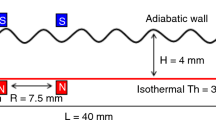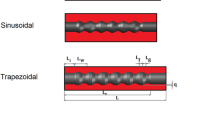Abstract
The flow and heat transfer characteristics of magnetic nanofluids in a circular channel under the action of magnetic fields were studied through numerical simulation based on the finite element method. The results show that there are obvious secondary vortices on the cross-section, and a swirling flow is formed in the duct under the coupling effects of the magnetic field, velocity distribution, and thermal variations which destroys the boundary layer, accelerates the mixing of fluids, and enhances heat transfer. In the studied range, the maximum heat transfer coefficient can be increased by 102.65 %, and the maximum comprehensive heat transfer factor J is 1.69 compared to the ferrofluid not affected by the external magnetic field. In addition, the effect of enhancing heat transfer gradually decreases with the increase of θ, until heat transfer is slightly inhibited when the magnetic field is parallel to the flow direction.
Similar content being viewed by others
Change history
05 October 2023
An Erratum to this paper has been published: https://doi.org/10.1007/s12206-023-0947-y
Abbreviations
- D :
-
Inner diameter
- l :
-
Total length
- a :
-
Thickness
- q :
-
Heat flux
- T :
-
Temperature
- C P :
-
Specific heat
- F m :
-
Kelvin body force
- M :
-
Magnetization
- B :
-
Magnetic flux density
- H :
-
Magnetic field intensity
- Re :
-
Reynolds number
- U :
-
Axial speed
- P :
-
Pressure drop
- h :
-
Heat transfer coefficient
- f :
-
Flow resistance coefficient
- U* :
-
Axial relative velocity
- T* :
-
Dimensionless temperature
- Fz :
-
Magnetic force in the z direction
- Fy :
-
Magnetic force in the y direction
- T0 :
-
At reference [300K]
- J :
-
Comprehensive heat transfer factor
- ∅:
-
Volume fraction
- ρ :
-
Density
- θ :
-
Angles
- μ :
-
Dynamic viscosity
- χ m :
-
Magnetic susceptibility
- β :
-
Thermal expansion coefficient
- k :
-
Thermal conductivity
- μ 0 :
-
Permeability of free space
- η :
-
Heat transfer enhancement rate
- ϑ :
-
Flow resistance growth rate
- α :
-
Boltzmann constant
- δ :
-
Correction function of Fe3O4
- in :
-
Inlet
- nf :
-
Nanofluid
- f :
-
Fluid
- np :
-
Nanoparticle
- 0:
-
No magnetic field [0G]
- w :
-
Inter wall
- ave :
-
Average
References
K. Wang, M.-X. Lin, Y.-R. Zhao and Y. Yu, Numerical study of flow and enhanced heat transfer of Cu−H2O nanofluid, Energy Conservation, 40(1) (2021) 21–23+27.
M. A. Hafiz, In tube convection heat transfer enhancement: SiO2 aqua based nanofluids, Journal of Molecular Liquids, 308(C) (2020) 113031.
R. K. Ajeel, W. S.-I. Salim, K. Sopian, M. Z. Yusoff, K. Hasnan, A. Ibrahim and A. H. A. Al-Waeli, Turbulent convective heat transfer of silica oxide nanofluid through corrugated channels: An experimental and numerical study, International Journal of Heat and Mass Transfer, 145(C) (2019) 118806.
J. H. He and N. Y. A. Elazem, The carbon nanotube-embedded boundary layer theory for energy harvesting, Facta Universitatis Series: Mechanical Engineering, 20(2) (2022) 211–235.
J. H. He and N. Y. Abd-Elazem, Insights into partial slips and temperature jumps of a nanofluid flow over a stretched or shrinking surface, Energies, 14(20) (2021) 6691.
T. R. Shah, H. Koten and H. M. Ali, Performance effecting parameters of hybrid nanofluids, Hybrid Nanofluids for Convection Heat Transfer, Academic Press (2020) 179–213.
N. Dogan, F. Ozel and K. H. Structural, Morphological, and magnetic characterization of iron oxide nanoparticles synthesized at different reaction times via thermal decomposition method, Current Nanoscience, 19(1) (2023) 33–38.
M. Al Barody Sadeem, A. Haslina and S. A. Martha Zoya, Evaluation of a novel quadruple combined cycle with the magnetohydrodynamic generator based on 6E analysis, J. Energy Resour. Technol, 143(7) (2021) 072104.
M. S. Ding, Q. Z. Liu and T. Jiang, Simulation of magnetohydrodynamic heat shield system on reusable launch vehicles, Acta Aeronautica et Astronautica Sinica, 42(7) (2021) 124501.
H. Yamaguchi, H. Yamasaki and T. Bessho, Development of magnetically-driven cooling device with concentric pipe structure, Proceedings of the Institution of Mechanical Engineers, Part C: Journal of Mechanical Engineering Science, 233 (13) (2019).
G.-L. Peng and J.-J. Zhang, Hydro-Magneto-PIC hybrid model for description of debris motion in high altitude nuclear explosions, Acta Physica Sinica, 70(18) (2021) 113–119.
D. Laurence, S. Dimitri, V. Pierre, M. Sylvain and J. Ribot Emeline, Micron-sized iron oxide particles for both MRI cell tracking and magnetic fluid hyperthermia treatment, Scientific Reports, 11 (1) (2021).
Y. Xuana and W. Roetzelb, Conceptions for heat transfer correlation of nanofluids, International Journal of Heat and Mass Transfer, 43 (2000) 3701–3707.
J. Koo and C. Kleinstreuer, A new thermal conductivity model for nanofluids, Journal of Nanoparticle Research, 6 (2004) 577–588.
E. Fattahi, M. Farhadi, K. Sedighi and H. Nemati, Lattice Boltzmann simulation of natural convection heat transfer in nanofluids, International Journal of Thermal Sciences, 52 (2012) 137–144.
M. Hojjat, S. G. Etemad, R. Bagheri and J. Thibault, Turbulent forced convection heat transfer of non-Newtonian nanofluids, Experimental Thermal and Fluid Science, 35(7) (2011) 1351–1356.
S. J. Yaksha, E. Akash, U. Sanjay and B. Balesh, Analysis of forced convection heat transfer in laminar flow through a compact pipe filled with nanofluids using CFD, Journal of Physics: Conference Series, 1854 (1) (2021).
S. Mohamed, B. Abourida, L. Belarche and Z. Arkadiusz, Numerical simulation of the natural convection with presence of the nanofluids in cubical cavity, Mathematical Problems in Engineering, 2020 (2020) 8375405.
S. Ramalingam, R. Dhairiyasamy, M. Govindasamy and V. M. Rajavel Muthaiah, Consequence of nanoparticles size on heat transfer characteristics of a radiator, Powder Technology, 367 (2020) 213–224.
T. Ambreen and M.-H. Kim, Effects of variable particle sizes on hydrothermal characteristics of nanofluids in a microchannel, International Journal of Heat and Mass Transfer, 120 (2018) 490–498.
F. Liu, Y. Cai, L. Wang and J. Zhao, Effects of nanoparticle shapes on laminar forced convective heat transfer in curved ducts using two-phase model, International Journal of Heat and Mass Transfer, 116 (2018) 292–305.
Z. Abdelmalek, A. D’Orazio and A. Karimipour, The effect of nanoparticle shape and microchannel geometry on fluid flow and heat transfer in a porous microchannel, Symmetry, 12 (4) (2020).
D. Y. Aydin, M. Gürü, A. Sözen and E. Çiftçi, Investigation of the effects of base fluid type of the nanofluid on heat pipe performance, Proceedings of the Institution of Mechanical Engineers Part A Journal of Power and Energy, 235(1) (2021) 124–138.
M. Z. Saghir and C. Welsford, Forced convection in porous media using Al2O3 and TiO2 nanofluids in differing base fluids, Energies, 13 (10) (2020).
S. Mukherjee, S. R. Panda, P. C. Mishra and P. Chaudhuri, Enhancing thermophysical characteristics and heat transfer potential of TiO2/water nanofluid, International Journal of Thermophysics: Journal of Thermophysical Properties and Thermophysics and Its Applications, 41 (12) (2020).
L. T. Tsz, S. Hamidon, K. Amir and K. Hasan, Thermal performance evalua-tion for different type of metal oxide water based nanofluids, Case Studies in Thermal Engineering, 27 (2021) 101288.
R. Ganguly, S. Sen and I. K. Puri, A new thermal conductivity model for nanofluids, Journal of Magnetism and Magnetic Materials, 271 (2004) 63–73.
B. Sun, Y. Guo, D. Yang and H. Li, The effect of constant magnetic field on convective heat transfer of Fe3O4/water magnetic nanofluid in horizontal circular tubes, Applied Thermal Engineering, 171(C) (2020) 114920.
M. Asfer, B. Mehta, A. Kumar, S. Khandekar and P. K. Panigrahi, Effect of magnetic field on laminar convective heat transfer characteristics of ferrofluid flowing through a circular stainless steel tube, International Journal of Heat and Fluid Flow, 59 (2016) 74–86.
M. Bahiraei, M. Hangi and A. Rahbari, A two-phase simulation of convective heat transfer characteristics of water-Fe3O4 ferrofluid in a square channel under the effect of permanent magnet, Applied Thermal Engineering, 147 (2019) 991–997.
M. Bezaatpour and M. Goharkhah, Convective heat transfer enhancement in a double pipe mini heat exchanger by magnetic field induced swirling flow, Applied Thermal Engineering, 167(C) (2020) 114801.
M. Bezaatpour and H. Rostamzadeh, Heat transfer enhancement of a fin-and-tube compact heat exchanger by employing magnetite ferrofluid flow and an external magnetic field, Applied Thermal Engineering, 164(C) (2020) 114462.
M. Ghalambaz, M. Sabour, S. Sazgara, I. Pop and R. Trâmbiţaş, Insight into the dynamics of ferrohydrodynamic (FHD) and magnetohydrodynamic (MHD) nanofluids inside a hexagonal cavity in the presence of a non-uniform magnetic field, Journal of Magnetism and Magnetic Materials, 497(C) (2020) 166024.
X.-H. Sun, M. Massoudi, N. Aubry, Z.-H. Chen and W.-T. Wu, Natural convection and anisotropic heat transfer in a ferronanofluid under magnetic field, International Journal of Heat and Mass Transfer, 133 (2019) 581–595.
F. Selimefendigil, H. F. Oztop, M. A. Sheremet and N. A. Hamdeh, Forced convection of Fe3O4-water nanofluid in a bifurcating channel under the effect of variable magnetic field, Energies, 12 (4) (2019).
M. Motozawa, K. Kino, T. Sawada, Y. Kawaguchi and M. Fukuta, Effect of magnetic field direction on forced convective heat transfer of magnetic fluid, Journal of the Japan Society of Applied Electromagnetics and Mechanics, 23 (3) (2015).
C. N. Marin and I. Malaescu, Experimental and theoretical investigations on thermal conductivity of a ferrofluid under the influence of magnetic field, The European Physical Journal E, 43 (2020).
D. D. Dixit and A. Pattamatta, Effect of uniform external magnetic-field on natural convection heat transfer in a cubical cavity filled with magnetic nano-dispersion, International Journal of Heat and Mass Transfer, 146(C) (2020) 118828.
M. Goharkhah, M. Ashjaee and J. Jamali, Experimental investtigation on heat transfer and hydrodynamic behavior of magnetite nanofluid flow in a channel with recognition of the best models for transport properties, Experimental Thermal and Fluid Science, 68 (2015) 582–592.
J. Koo and C. Kleinstreuer, A new thermal conductivity model for nanofluids, Journal of Nanoparticle Research, 6 (2004) 577–588.
L. Sha, Y. Ju and H. Zhang, Experimental investigation of convective heat transfer coefficient using Fe3O4/water nanofluids under different magnetic field in laminar flow, CIESC Journal, 69(4) (2018)1349–1356.
Author information
Authors and Affiliations
Corresponding author
Additional information
Gong Bin is a Professor of the School of Mechanical and Power Engineering, Shenyang University of Chemical Technology, China. His research interests include the industrial application and application basis of chemical process intensification technology.
Rights and permissions
About this article
Cite this article
Wang, C., Rong, D., Zhang, W. et al. The flow and heat transfer performances of magnetic nanofluid in a duct in presence of magnetic fields with different direction. J Mech Sci Technol 37, 4899–4909 (2023). https://doi.org/10.1007/s12206-023-0843-5
Received:
Revised:
Accepted:
Published:
Issue Date:
DOI: https://doi.org/10.1007/s12206-023-0843-5




